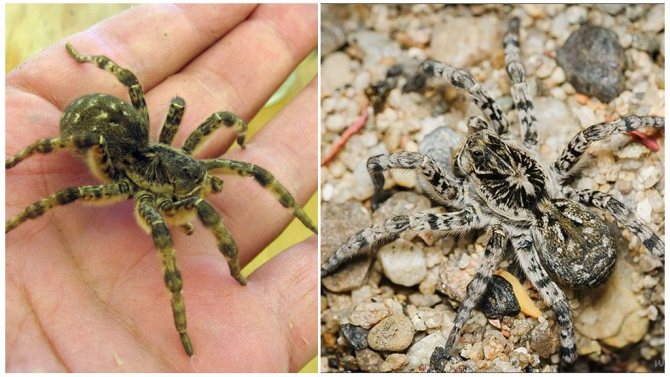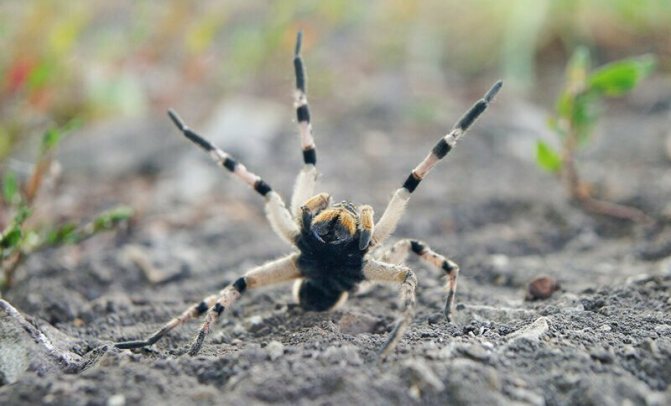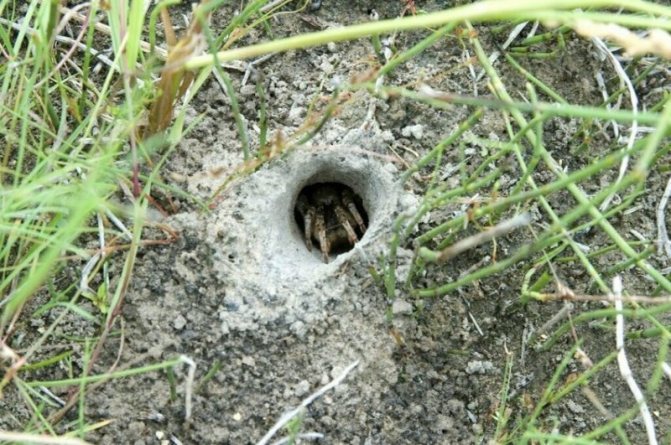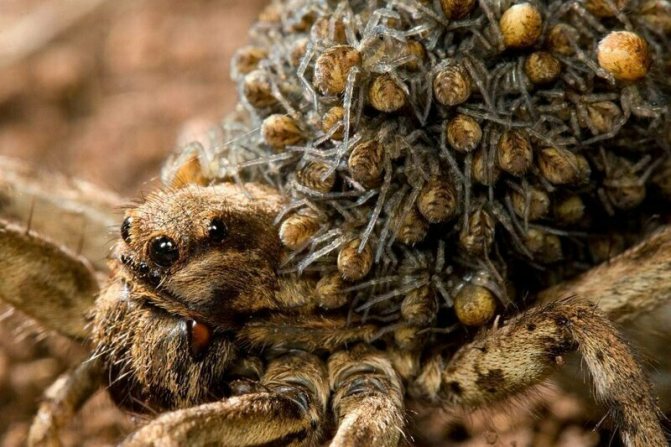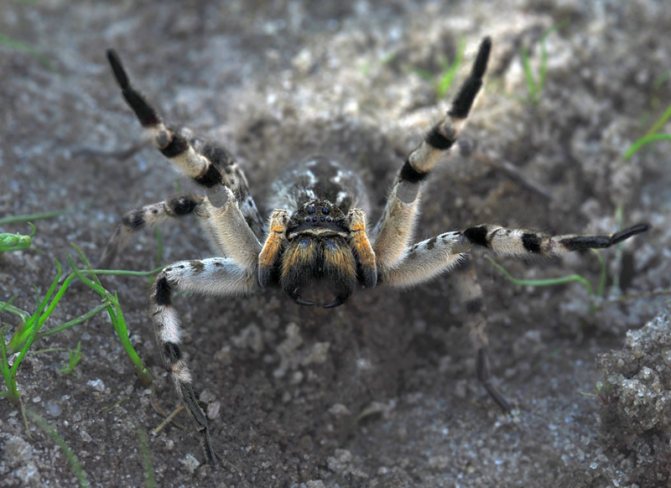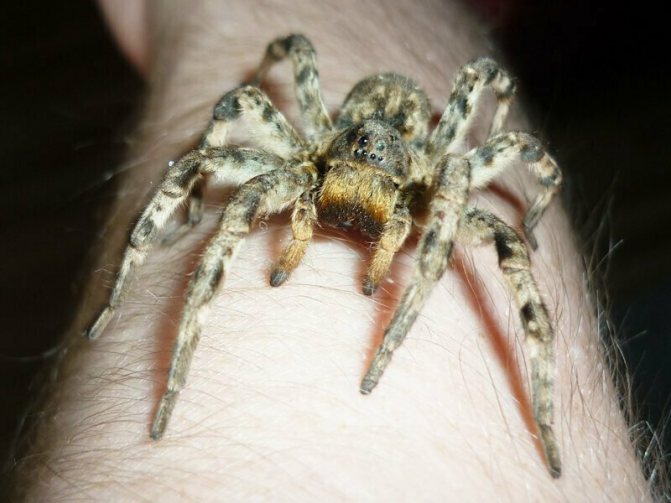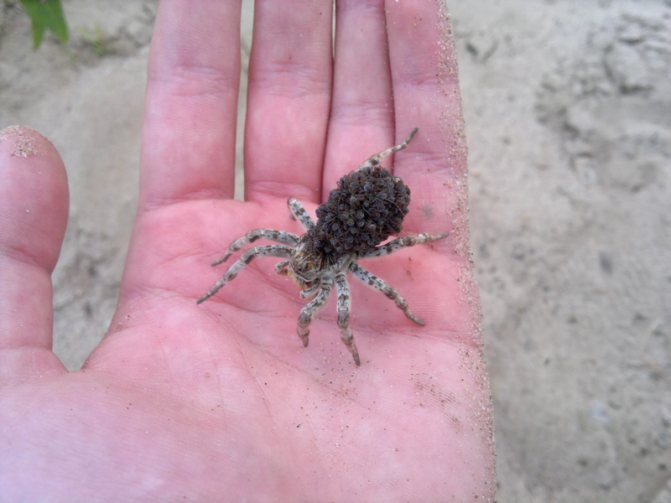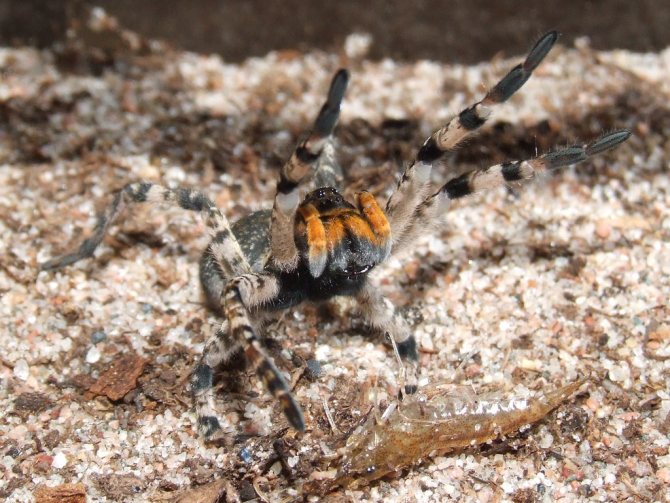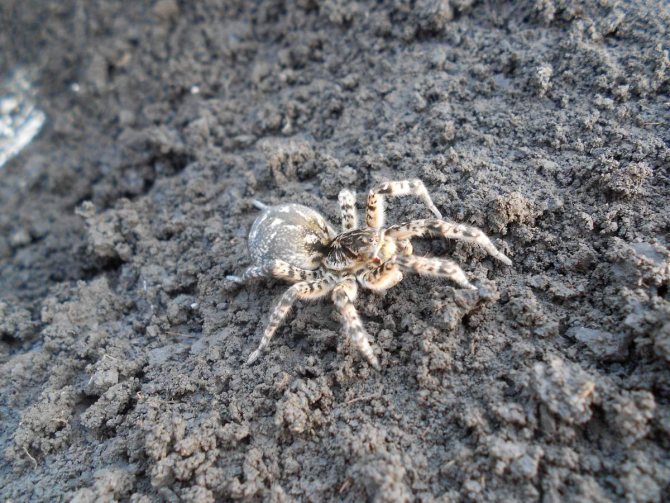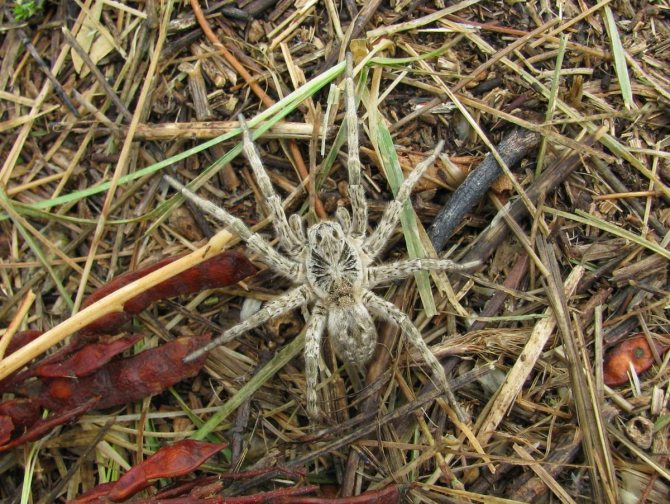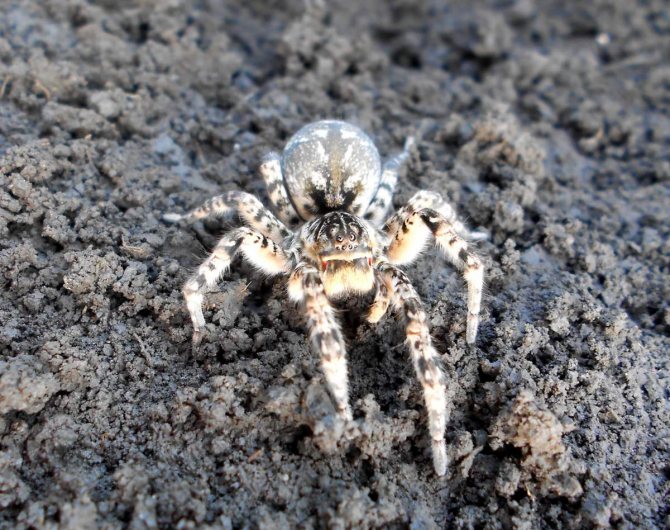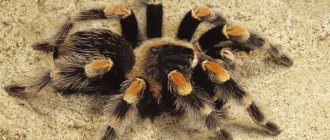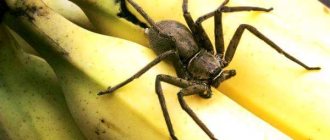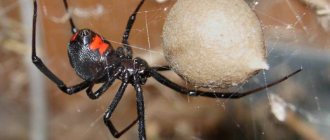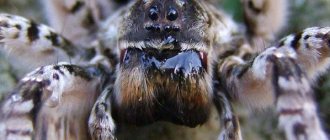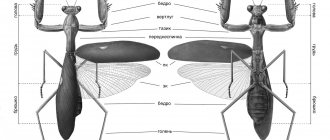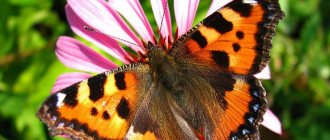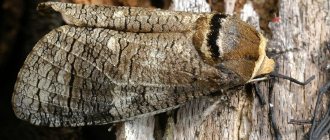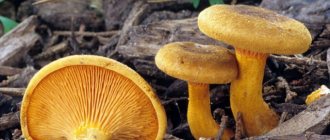| South Russian tarantula (mizgir) | ||
| Scientific classification | ||
| intermediate ranks Domain: | Eukaryotes | |
| Kingdom: | Animals |
| Subkingdom: | Eumetazoi |
| No rank: | Bilaterally symmetrical |
| No rank: | Protostomes |
| No rank: | Shedding |
| No rank: | Panarthropoda |
| A type: | Arthropods |
| Subtype: | Cheliceral |
| Class: | Arachnids |
| Detachment: | Spiders |
| Suborder: | Opisthothelae |
| Infraorder: | Araneomorphic spiders |
| Clade: | Neocribellatae |
| Series: | Entelegynae |
| Superfamily: | Lycosoidea |
| Family: | Wolf spiders |
| Genus: | Tarantulas |
| View: | South Russian tarantula (mizgir) |
Laxmann, 1770
| NCBI | 434756 |
| EOL | 1197470 |

Nora tarantula, steppe of the Kherson region
South Russian tarantula
[1] (in common people
misgir
[2]; lat. Lycosa singoriensis) is a species of spider from the wolf spider family (
Lycosidae
).
Origin of the species and description
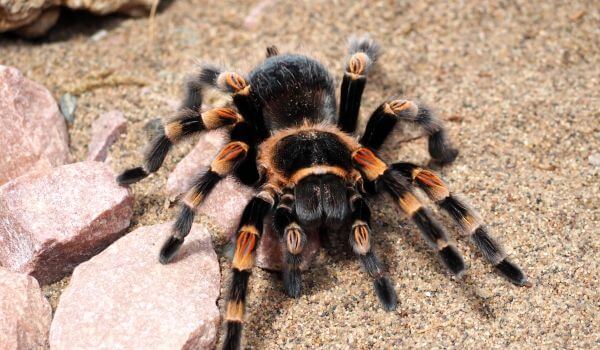

Photo: Spider tarantula
The genus Lycosa comes from the wolf spider family. The name of the species originated in the Renaissance. In the past, Italian cities were teeming with these arachnids, which is why many bites accompanied by convulsive conditions were recorded. The disease was called tarantism. Most of those bitten were noted in the city of Taranto, where the name of the spider came from.
Interesting fact: For recovery, medieval healers attributed the sick to the point of dancing the Italian dance tarantella, which also originated in Taranto, located in southern Italy. Doctors believed that only this would save the bitten from death. There is a version that all this was arranged for feasts hidden from the eyes of the authorities.
The genus belongs to the type of arthropods and has 221 subspecies. The most famous of these is the Apulian tarantula. In the 15th century, its poison was believed to cause insanity and many epidemiological diseases. It has now been proven that the toxin has no effect on humans. The South Russian tarantula lives in Russia and Ukraine and is known for its black cap.
Interesting fact: The species Lycosa aragogi, found in Iran, is named after the huge spider Aragog from the books about the young wizard "Harry Potter".
In many European languages, the word tarantula denotes tarantulas. This leads to confusion when translating texts from foreign languages, in particular, from English. In modern biology, groups of tarantulas and tarantulas do not intersect. The former belong to the araneomorphic spiders, the latter to the migalomorphic ones.
What to do in case of a bite
If the tarantula still bites a person, it is important to quickly take measures that will prevent infection of the wound and allow the skin to recover as soon as possible. Having realized that a bite has occurred, it follows:
- Treat the bite site with any antiseptic (preferably pre-washing with soap and water). For these purposes, you can use hydrogen peroxide, alcohol and even vodka.
- Apply a cooling compress to relieve pain.
- Take an antihistamine to prevent complications of an allergic reaction caused by a bite.
- An anti-inflammatory ointment or antibiotic such as Levomekol or Levomycetin can be applied to the skin.
- A person should drink plenty of fluids. This will activate the elimination of the poison from the body.
- It is important to hold the bitten limb at first, lifting it up.
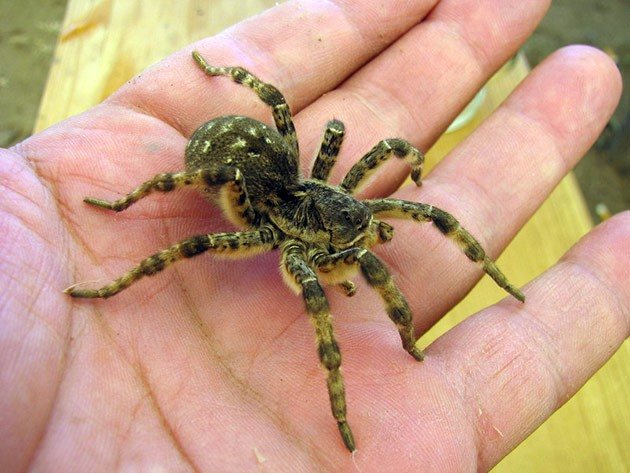

The tarantula's blood contains a substance that neutralizes poison.It is enough to crush the arachnid and smear the bite with its blood. The Italians, who gave the tarantula a sonorous name, fought spider bites with active dances in the past. There is a sense in active movements, which consists in activating the movement of blood and saturating it with oxygen. It is not known whether this method helped against the poison, but it was this original method that gave the world the popular dance "tarantella".
In Central Asia, the consequences of the bite of any poisonous spider are fought in a simple improvised way. It is enough to burn the area with a match. This method, based on high temperature, quickly destroys the poison and eliminates the unpleasant consequences of meeting with a tarantula.
Appearance and features
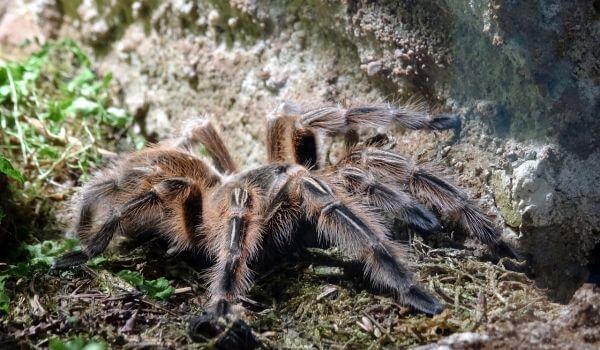

Photo: Poisonous spider tarantula
The entire body of the spider is covered with fine hairs. The structure of the body is divided into two main parts - the abdomen and the cephalothorax. On the head there are 4 pairs of eyes, 2 of which are small and lined up in a straight line, the rest form a trapezoid by their location.
Video: Spider tarantula
This placement allows you to see everything around a 360-degree view. In addition to a well-developed visual apparatus, tarantulas have a supersensitive sense of smell. This gives them the ability to smell prey at fairly large distances.
The size of the arthropods is quite large:
- body length - 2-10 cm;
- leg length - 30 cm;
- the weight of females is up to 90 g.
Like other insects, female spiders are much larger than males. Throughout their lives, individuals molt several times. The more often this happens, the faster they age. On four pairs of long hairy paws, the spider moves comfortably over sand or water surfaces. The forelimbs in males are more developed than in females.
Interesting fact: The limbs can only bend, so the injured individual becomes weak and vulnerable. The legs are bent thanks to the flexor muscles, and unbend under the pressure of the hemolymph. The skeleton of arachnids is also weak, so any fall can be their last.
Chelicerae (mandibles) are equipped with poisonous ducts. Thanks to them, arthropods can defend or attack. Spiders are usually gray, brown or black in color. Sexual dimorphism is well developed. The largest are the American tarantulas. Their European counterparts are significantly inferior to them in size.
Home content
If you decide to keep a South Russian tarantula at home, then in this case, remember that it is quite fast and does not tolerate mistakes in handling. When trying to defend himself, he can jump to a height of about 15 cm and will certainly bite.
As for the content itself, the South Russian tarantula is unpretentious. He needs:
- a vertical terrarium from which the spider cannot get out on its own;
- a fairly thick layer of substrate - at least 30 cm so that your pet can dig its burrows in it;
- a drinking bowl, in which there will be clean and fresh water every day, while the spider should have free access to it;
- food - for the South Russian tarantula, I usually buy food insects, the body size of which should correspond to the body size of the spider itself.
Important! It is highly discouraged to feed the South Russian tarantula with insects from the street!
Where does the tarantula spider live?
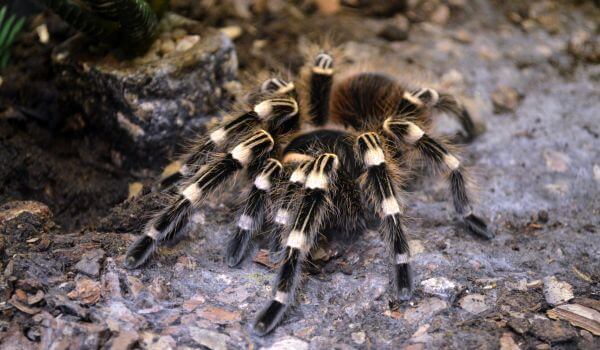

Photo: Spider tarantula from the Red Book
The habitats of the species are represented by a wide range - the southern part of Eurasia, North Africa, Australia, Central and Asia Minor, America. Representatives of the genus can be found in Russia, Portugal, Italy, Ukraine, Spain, Austria, Mongolia, Romania, Greece. For habitation, arthropods choose arid regions.
They settle mainly in:
- deserts;
- steppes;
- semi-deserts;
- forest-steppe;
- gardens;
- vegetable gardens;
- on the fields;
- meadows;
- along the banks of the rivers.
Tarantulas are thermophilic arachnids, so they cannot be found in the northern cold latitudes.Individuals are not particularly picky in their habitats, therefore they live even in saline steppes. Some people manage to get into houses. Distributed in Turkmenistan, the Caucasus, South-West Siberia, Crimea.
Most predatory spiders prefer to live in burrows that they dig themselves. They choose the place for their future housing very carefully. The depth of vertical burrows can reach 60 centimeters. They carry pebbles to the side, and rake the earth with their paws. The walls of the tarantula's shelter are covered with cobwebs. It vibrates and allows you to assess the situation outside.
At the end of autumn, spiders prepare for wintering and deepen the dwelling to a depth of 1 meter. The entrance to the hole is plugged with leaves and branches. In the spring, animals crawl out of the house and drag the cobwebs behind them. If it suddenly breaks off, there is a high probability that the animal will no longer find its shelter and it will have to dig a new hole.
Now you know where the tarantula spider lives. Let's see what the poisonous spider eats.
What does a tarantula spider eat?
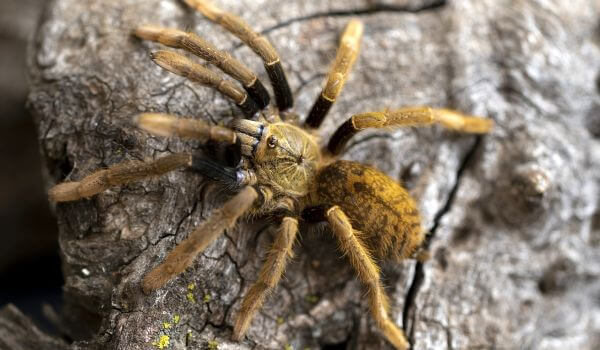

Photo: Spider tarantula in Russia
Tarantulas are real predators. They wait for their victims from ambush, and then swiftly attack them.
The diet of arthropods includes many insects and amphibians:
- Zhukov;
- caterpillars;
- cockroaches;
- bear;
- crickets;
- ground beetles;
- small frogs.
Having caught prey, arachnids inject their poison into it, thereby paralyzing it. When the poison begins to act, the internal organs of the victim turn into a liquid substance, which after some time the tarantulas are sucked out like a cocktail.
Usually, predators choose their prey according to their size and stretch the food intake for several days. Individuals can do without food for a long time, but a constant source of water is a must. There is a known case when a female tarantula was able to do without food for two years.
Near the burrow, arachnids pull on signal threads. As soon as they feel that someone is crawling past their home, they immediately crawl out and grab the prey. If the prey is large, the predator jumps back and jumps on it again to bite again.
If the prey tries to escape, the spider pursues it for up to half an hour, from time to time inflicting new bites. All this time he tries to be at a safe distance from the victim. Usually at the end of the battle, the animal gets its way and gets a well-deserved dinner.
Virulence
The poison of the South Russian tarantula is in the glands in the cephalothorax; their ducts open at the apex of the claw-like segments of the chelicera, with which spiders pierce the cuticle of their prey in order to inject poison and digestive enzymes, and then suck out the internal contents of the prey. Its bite for humans is comparable in pain to that of a hornet and causes only local edema. The poison does not cause death in large animals and humans due to the weak activity and low concentration of protein toxins that paralyze the nervous system. After a bite, a person develops swelling and pain in the bitten site, sometimes the skin turns yellow and remains so for about two months [2].
Features of character and lifestyle


Photo: Spider tarantula
Tarantulas, unlike their fellows, do not weave webs. They are active hunters and prefer to catch their prey on their own. They use the web as traps to find out about a beetle or other insect running by. Weaves can warn of impending danger.
All day arthropods sit in a hole, and in the evening they get out of the shelter to hunt. With the onset of cold weather, they seal the entrance to their cave and hibernate. Among the individuals, there are real centenarians. Some subspecies can exist for up to 30 years. The main part of the species lives on average for 3-10 years. Females have a longer life span.
The growth of the spider does not stop at any stage of development. Therefore, their exoskeleton changes several times as they grow older. This enables the animal to regrow lost limbs. With the next molt, the leg will grow back, but it will be much smaller than the rest of the limbs. Subsequently, the next molts, it will reach its normal size.
Fun Fact: Mostly spiders move along the ground, but sometimes they climb trees or other objects. Tarantulas have claws on their legs, which they, like cats, release to have better grip on the surface they climb.
Poisonous or not?
One of the most important questions associated with tarantulas - are they poisonous or not, are they dangerous to humans? Despite the mass of legends, many misguided people and confusion with other species of spiders, the tarantula is believed to be dangerous. Yes, the spider is poisonous, and its venom can kill, but only animals. A tarantula cannot harm a person, and its bite will be akin to a bee or hornet bite. Moreover, the tarantula will not look for you and attack, despite the fact that it is a predator. You can provoke him to attack only by invading his territory or destroying his house (banal self-defense).
It is important to understand that
do not deliberately ask for a spider attackwhich is unknown to you. At certain times of the year, for example, in the spring, at this time the spider venom gains strength (it is more toxic) and some individuals with their bite can lead to unpleasant consequences. An infected person may experience nausea, dizziness and others like them (not fatal, but creepy and unpleasant).
In terms of the degree of danger, the poison varies depending on the season:
- Spring - at this time the spiders wake up, have a rather weak venom;
- Summer - finally awake, the poison increases several times;
- Autumn - the power of the poison is declining again due to the approaching hibernation.
Social structure and reproduction
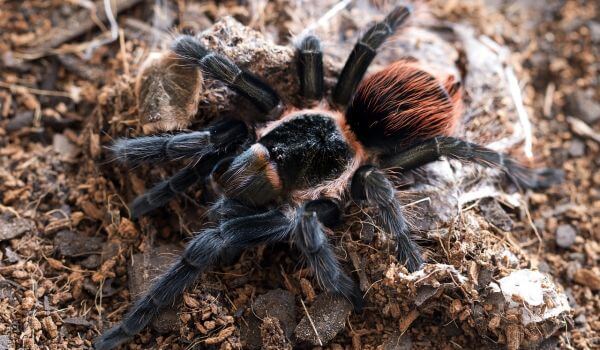

Photo: Poisonous spider tarantula
The period of sexual activity occurs in the last month of summer. The male weaves a web, after which he begins to rub his belly against it. This provokes the ejaculation of seminal fluid, which is poured out onto the cobweb. The male plunges his pedipalps into it, which absorb sperm and become ready for fertilization.
Next comes the stage of searching for a female. Having found a suitable candidate, the male emits vibrations with his belly and performs ritual dances, which attracts females. They lure hiding females by tapping their paws on the ground. If the partner reciprocated, the spider inserts its pedipalps into her cloaca and fertilization occurs.
Further, the male quickly retreats so as not to become food for his chosen one. The female weaves a cocoon in the hole, in which it lays eggs. At a time, their number can reach 50-2000 pieces. The female carries the offspring for another 40-50 days. The hatched babies move from the mother's abdomen to the back and stay there until they can hunt on their own.
The spiders grow quickly and soon begin to taste the prey caught by the mother. After the first molt, they scatter. By the age of 2-3 years, the predators become sexually mature. During this period, arthropods are deprived of the instinct of self-preservation and it is easy to meet them in broad daylight.
Natural enemies of tarantula spiders
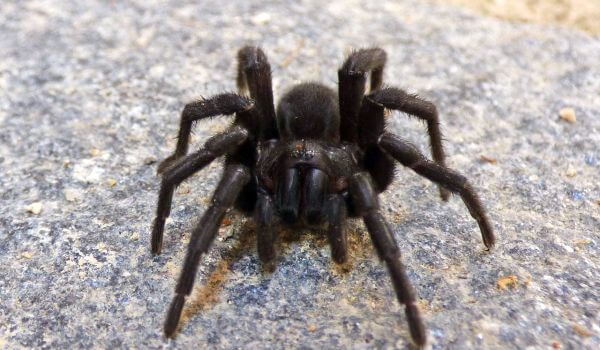

Photo: Black spider tarantula
The tarantula has enough enemies. Birds are the main culprits in the death of arthropods, since they are part of the bird's diet. Wasps attempt on the life of arachnids, just like spiders do with their victims. They inject poison into the body of the tarantula, paralyzing the predator.
They then lay their eggs inside the spider. Parasites live and develop, after which they get out. Natural enemies include some species of ants and praying mantises, which are not at all picky about food and absorb everything that moves. Frogs and lizards love tarantula.
The most dangerous enemy is still the same spider. Arthropods tend to eat each other. The female in the process of fertilization can encroach on the life of the male, like a female praying mantis, or eat her offspring if she cannot trap an insect.
An incessant feud is waged between tarantulas and bears. Their habitats overlap. Bears dig the soil, where spiders often climb. Sometimes individuals manage to escape. Wounded or molting arthropods usually become the enemy's food.
Basically, the population suffers most in early spring. When lethargic and sleepy arachnids crawl out of their shelters, the bear is right there. Sometimes they climb into spider holes and attack tarantulas with their front limbs, inflicting weighty blows. When the spider loses a lot of blood, the bear eats it.
Food
All insects and animals that are smaller than the tarantula are at risk of being eaten. For hunting, they do not go far from their burrow. They drag out their sacrifice and already eat at home. This happens in a somewhat unusual way.
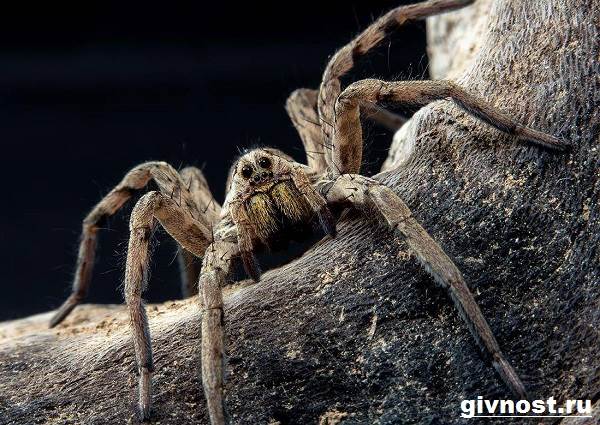

Spiders do not have teeth, so they, approaching their victim, pierce a hole in it, through which they inject their special agent to dissolve all the entrails of the victim. And after that, they suck out the dissolved contents without any problems.
Population and status of the species
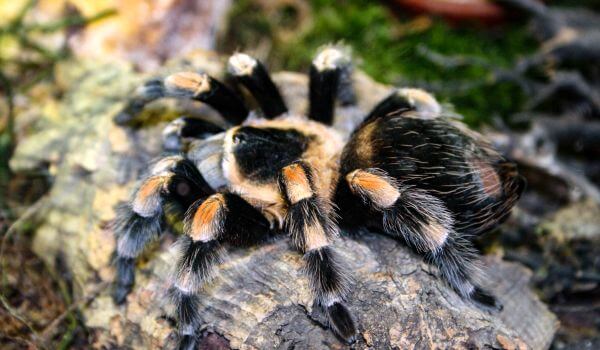

Photo: Spider tarantula
Tarantulas are most common in forest-steppe, steppe and desert areas. Their number is gradually decreasing every year, but over the past ten years, wolf spiders have managed to stop the process of population decline and even stabilize it. Climate warming had a beneficial effect on this.
Commercial activity is one of the main reasons for the decline in the number of arthropods. In third world countries, arachnids are caught in order to sell them for little money and earn a living. In countries with little developed economies, there is a significant decrease in the number of tarantulas.
From 1995 to 2004, in the Republic of Tatarstan, the species was recorded in Nizhnekamsk, Elabuga, Zelenodolsk, Tetyushsky, Chistopol, Almetyevsk districts, where its appearance was recorded from 3 to 10 times. Basically, individuals are found singly.
Tropical forests are being cut down at a significant rate due to population growth. Bolivia and Brazil use artisanal mining methods for gold and diamonds that destroy the soil. Water is pumped underground, as a result of which the integrity of the earth's surface is violated. This, in turn, leads to negative consequences for the existence of the animal world.
Habitat
The South Russian tarantula prefers a dry climate and soft soil, which it needs to equip its burrow. Desert, forest-steppe, steppe, semi-desert are suitable for Mizgir. Can be found in gardens and vegetable gardens.
An important condition is that there must be moisture nearby underground. That is why mizgir minks in desert areas are an indicator of the presence of groundwater. The presence of the tarantula is also indicated by the grass Salleros, a burrowing insect of a bear.
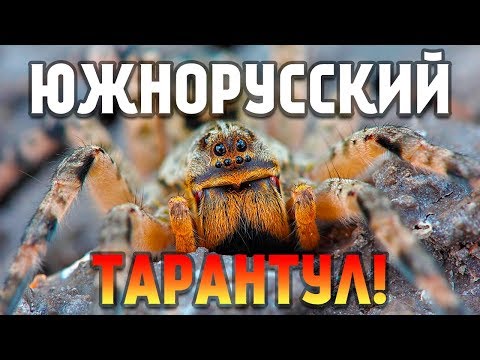

Regions of Russia where the South Russian tarantula lives:
- Kursk;
- Saratov;
- Belgorodskaya;
- Astrakhan;
- Orlovskaya;
- Tula;
- Lipetsk.
Misgir also lives in the Trans-Baikal, Stavropol Territories, on the territory of Kazakhstan, Bashkortostan, Belarus (mainly near the rivers), Central Asia and Ukraine.

